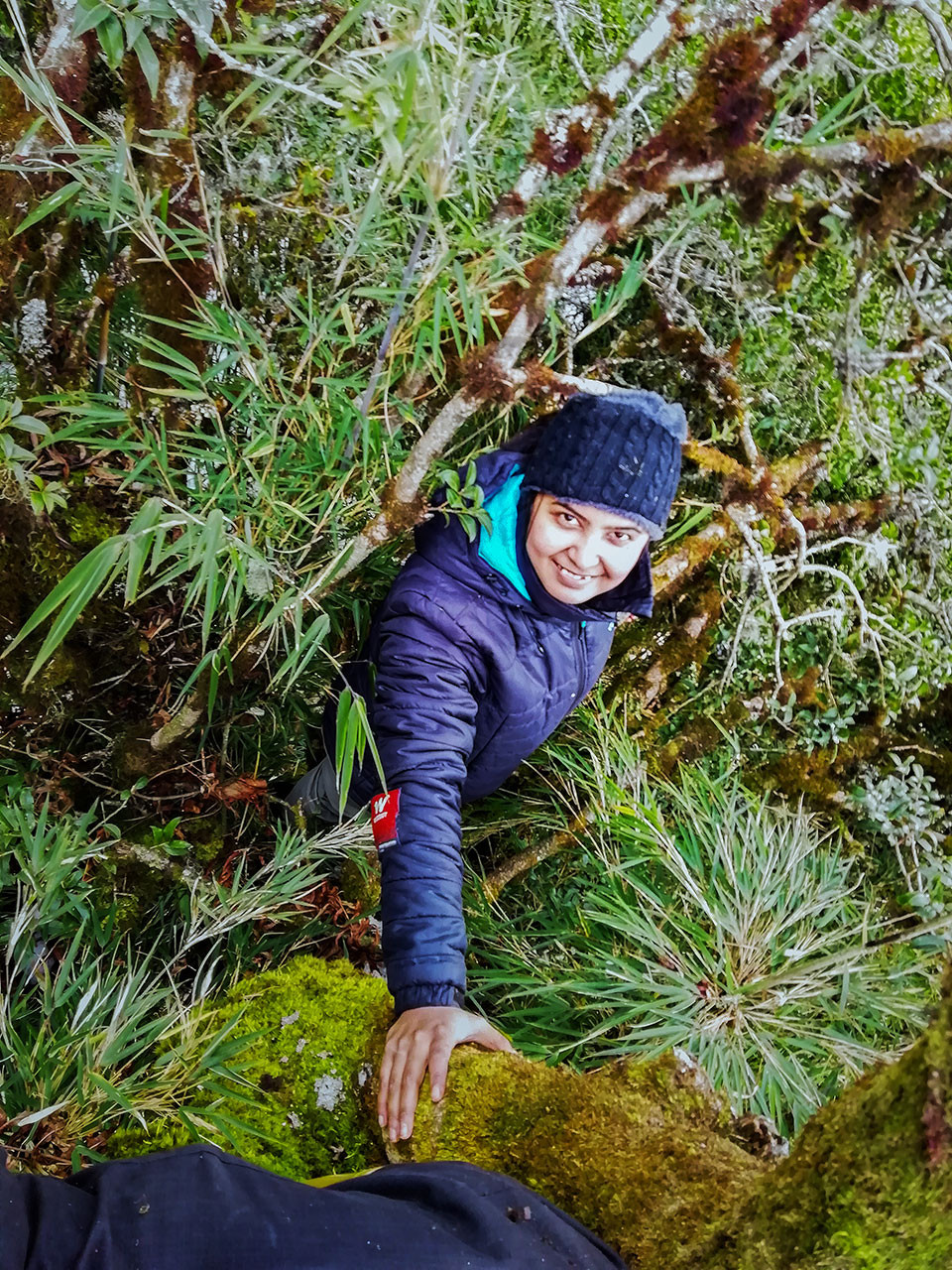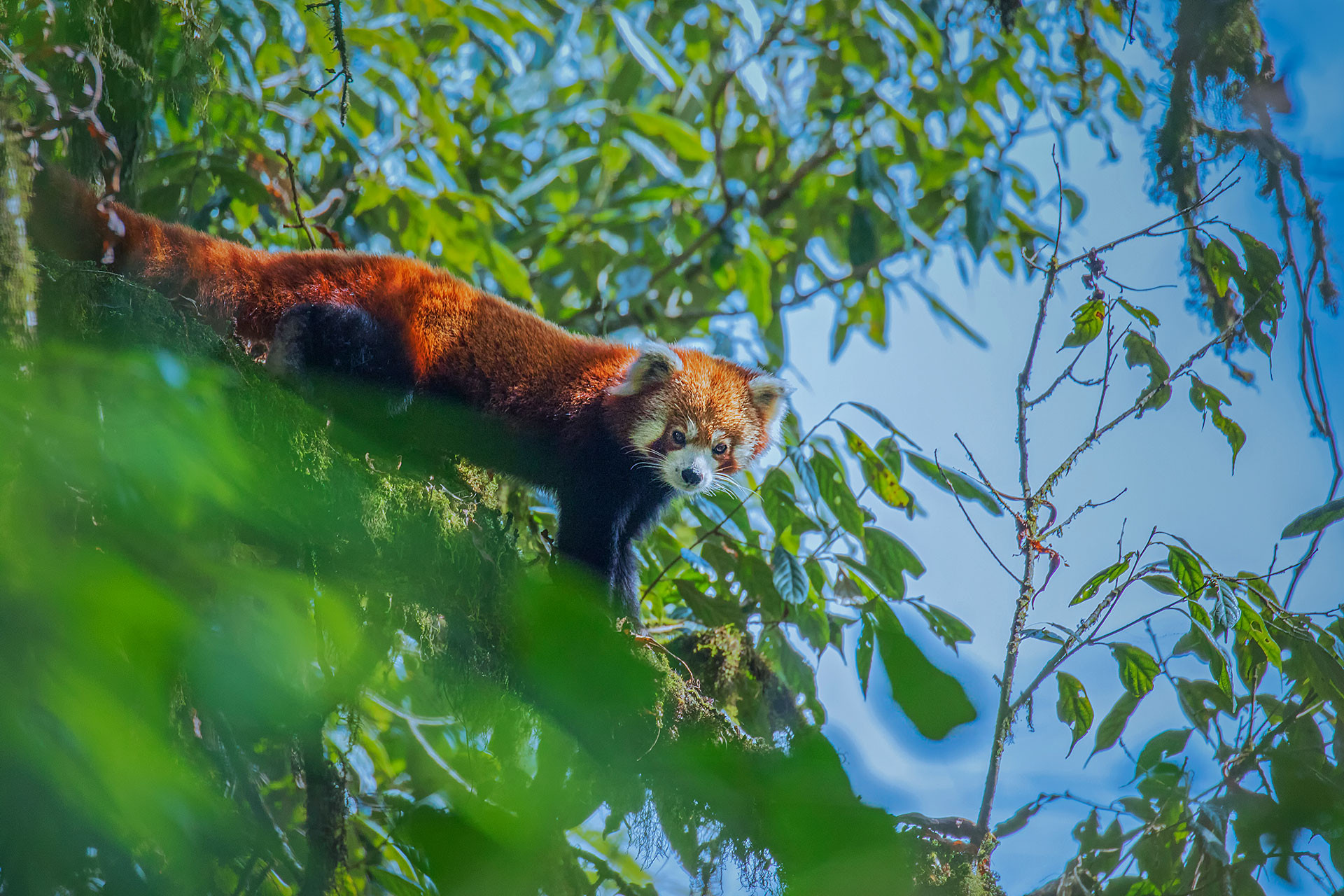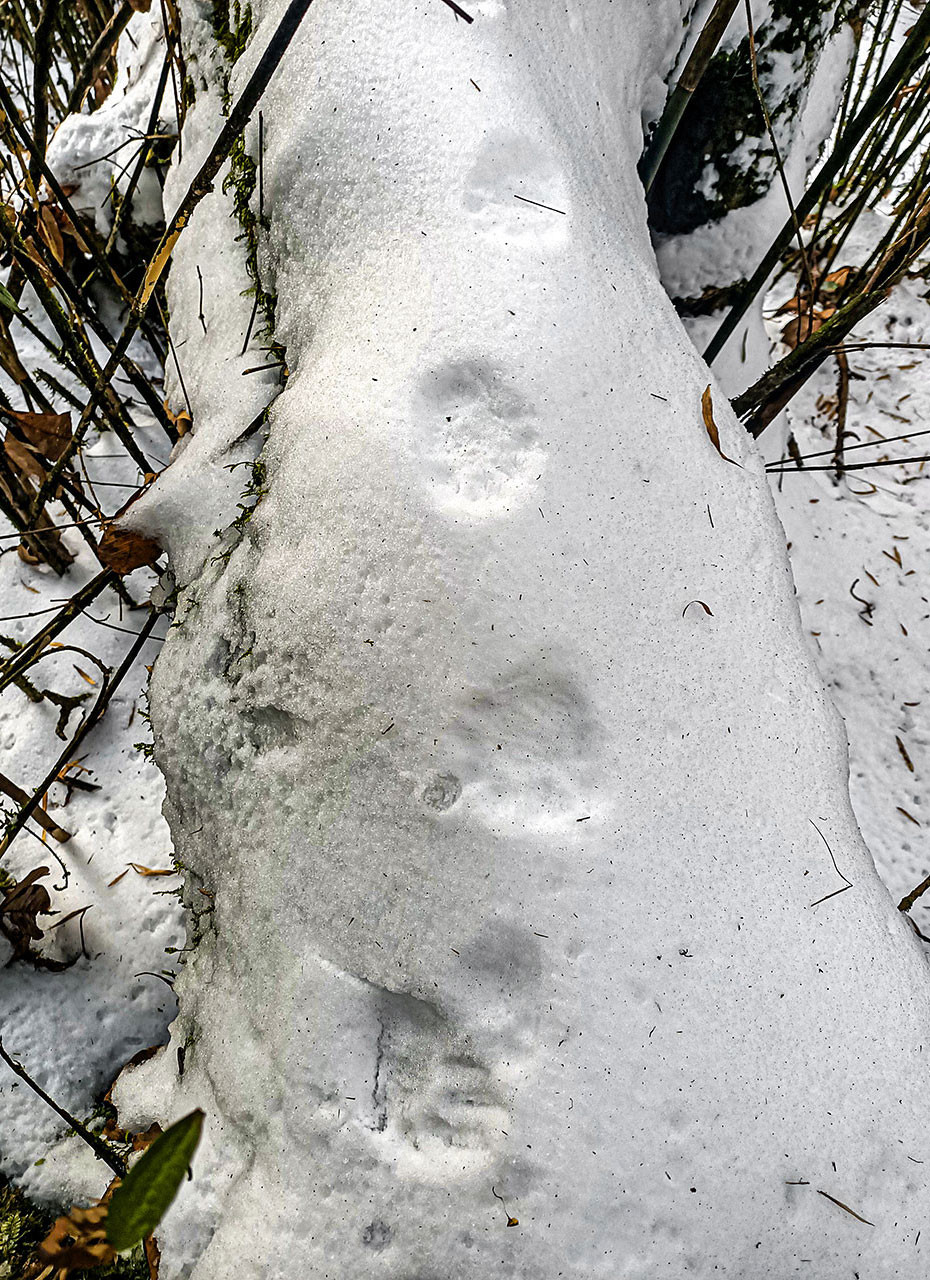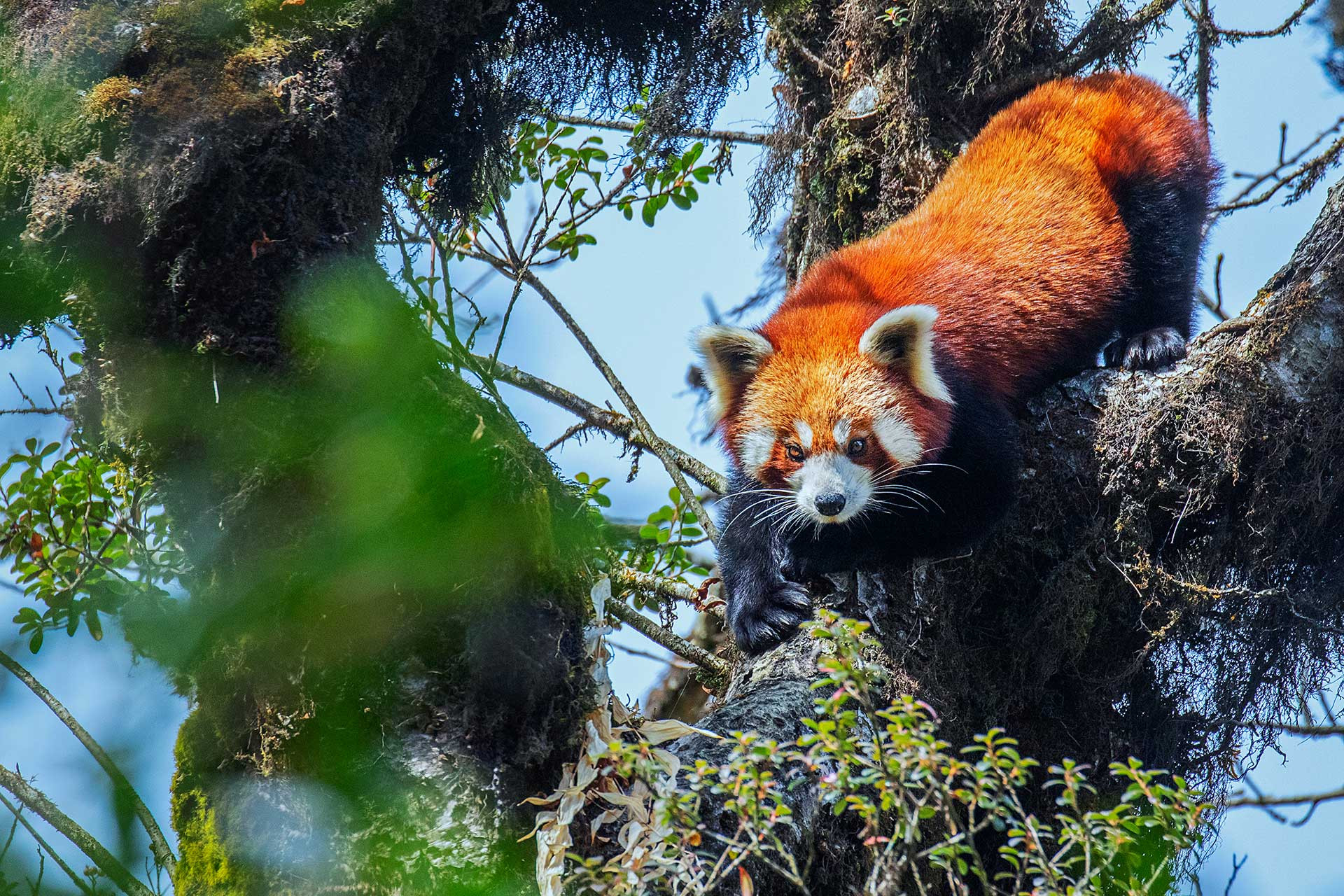It was 3–4 years ago when Moumita Chakraborty visited Singalila National Park in West Bengal, and an unexpected (for her) Red Panda sighting redefined the course of her life. "A special moment," she recalls, as she fell completely in love with the mysterious teddy bear-like animal of the Himalayas. Unable to find too many research papers or information on the internet about Red Pandas, she decided to move away from her ornithology roots and focus her efforts on studying this unique mammal.
"In hindsight, I guess I have always wanted to work on lesser-known mammals, small carnivores in particular," she reminisces. After working with WWF India as a Field Officer, where she surveyed many parts of Sikkim for the Red Panda, and once she had spent enough time in the field understanding the current plight of the species, Moumita joined the Wildlife Institute of India (WII) for her PhD in 2018.
Red Pandas are distributed in isolated pockets within the Himalayas—in West Bengal, Sikkim and Arunachal Pradesh. “I chose Sikkim because it is what you would call the heartland of Red Pandas in the country, with all the four districts of the state home to these mammals," Moumita explains. The first researcher to start working on Red Pandas outside protected areas, today, she is funded by National Geographic Photo Ark to understand and evaluate the species-habitat relationship of the Red Panda across both protected areas and non-protected areas of the Sikkim Himalayas.
In this interview, Moumita discusses her work on Red Pandas as a fellow of the ZSL EDGE of Existence programme and much more.
Before we start talking about conservation, could you narrate your most memorable sighting of a Red Panda in the wild?
Although I have been doing fieldwork in Sikkim for almost 3 1/2 years, I have sighted the Red Panda only six times in total in the wild. Every single time it has been incredibly special to see them. Last year, I saw the Red Panda three times, in North Sikkim and West Sikkim. Before that, I had a sighting while working for WWF and twice during my PhD years. Apart from that, I saw one in Singalila National Park, which was my very first sighting.
They are very shy creatures. Often, you tend to see them high up in the canopy, standing on a single branch. One of my sightings was so high up, I was able to see it only because I was carrying binoculars. The highest duration that these sightings last is maybe 10–15 mins. But I've been lucky enough to study and observe all their behaviours in these brief periods.
The recent split of the Red Panda into two different species, namely the Himalayan Red Panda and the Chinese Red Panda—what does it mean for the species from a conservation point of view?
Red Pandas belong to the Ailuridae family and are its sole living representatives. The earliest ancestors of the Red Panda within the order Carnivora (Parailurus sp, Simocyon batalleri, Pristinailurus sp), which lived in the Late Palaeocene and Eocene of Eurasia and North America, became extinct long back. With no living relatives, the Red Panda is known as one of the Earth’s living fossils, having existed for over 10 million years. However, a recent paper published in the journal Science Advances has concluded that there are two different species of Red Pandas. The Himalayan Red Panda (Ailurus fulgens fulgens), resident of the Eastern Himalayan forest (Nepal, Bhutan and India’s states of Sikkim, West Bengal and Arunachal Pradesh) and Chinese Red Panda (Ailurus fulgens styani), which lives in the mountain region of Northern Yunnan province, China.
Today, only approx. 300 Himalayan Red Pandas (Ailurus fulgens fulgens) remain in Sikkim, with less than 10,000 individuals globally. This gentle creature is recognised as Endangered by the IUCN Red List and classified as a CITES I species. Red Pandas face a very high mortality rate in the wild, especially the cubs, potentially why their populations are unable to recover. But the primary threat to Red Panda survival is habitat loss and fragmentation. Rapid human population growth and development projects in the Eastern Himalayas are causing deforestation, degradation and fragmentation of Red Panda habitats. The unsustainable use of forest by-products like timber, fuelwood, fodder, non-timber forest product (NTFP) and bamboo is depleting forest resources and reducing forest quality. Besides, livestock herding, free-roaming dogs and accidental poaching are also major contributors to Red Panda mortality. Sadly, weak law enforcement, the dearth of a management plan, low awareness and a lack of research interest are also pressing problems for the species.
Could you talk us through your work with EDGE that you started back in 2019?
During my PhD, I applied for the ZSL Edge of Existence Fellowship, which has been a great resource in helping me continue to build on my existing familiarity and experience with working on the species. Started in 2019, our work focuses on the conservation of the species through research, education and communication. The ZSL EDGE of Existence Programme and National Geographic Photo Ark coordinated with me to accomplish all activities in the Sikkim landscape. Under this extensive research project, ‘Spatial prioritisation for the conservation of endangered Red Panda in Sikkim Himalaya’, Red Pandas and their habitat are observed and monitored seasonally. The project looks into reserved and non-reserved forest areas and assesses habitat suitability based on species distribution patterns and threat categories. Simultaneously, through social interactions, our project envisages the relationship between people and the Red Panda in this habitat.
The project has been undertaken across the historical and potential range of the Red Panda (1800–4000m) in Sikkim (27°03′ to 28° 07′ N and 88° 03′ to 88° 57′E), covering seven protected networks (Shingba Rhododendron Sanctuary, Pangolakha Wildlife Sanctuary, Maenam Wildlife Sanctuary, Kyongnosla Alpine Sanctuary, Khangchendzonga National Park, Fambong Lho Wildlife Sanctuary and Varsey Rhododendron Sanctuary) and 11 reserve forest/non-protected areas (Naga RF, Lachung RF, Tarum RF, Sophaka RF, Nyesha RF, Tendong RF, Sada RF, Karchi RF, Bhusuk RF, Tumin RF, Sindrabung RF). Amongst these, we have obtained evidence (pellets and/or sightings) from all seven protected, and seven non-protected sites (Naga RF, Lachung RF, Tarum RF, Sada RF, Bhusuk RF, Tumin RF, Sindrabung RF).
We are constantly striving to raise awareness among local communities, arranging training programs with government departments, NGOs, schools and colleges around Red Panda habitats. EDGE encourages and supports youth initiatives in various ways. So far, we have trained 250 forest officials and conducted around ten awareness campaigns in schools/colleges/institutes in the region. We have also formed a group of young enthusiasts, ‘Red Panda on EDGE’, who come together regularly to implement ecological surveys in different non-protected sites in Sikkim. We hope that our efforts can contribute to larger landscape-level conservation and Red Panda management plans.
According to data from TRAFFIC, during the period between July 2010–June 2019, no incidents of poaching or illegal wildlife trade in Red Panda were reported from India. How would you define the relationship between the people of Sikkim and the Red Panda?
There is no conflict between the people of Sikkim and Red Pandas, but there are conflicts with other animals like the Asiatic Black Bear, Yellow-throated Marten and Wild Boar, to give a few examples. I have seen traps that are placed in the forest to kill or maim wild animals. Therefore, accidental poaching is potentially a problem for Red Pandas in the area.
Also, people keep going to the forest to cut trees, for example. Logging is also a large-scale activity in the region. Being arboreal by nature, certain tree species are important for feeding and roosting for Red Pandas. These mammals occupy specialised habitats like temperate broadleaf forests and subalpine conifers dominated by Fir, Himalayan Hemlock, Oak, Maple, Rhododendron, Juniper and bamboo thickets. I believe sensitisation begins with the people, and it is crucial to help them understand the significance of some of these trees to the Red Panda.
What next for Red Panda on EDGE? What are the immediate goals?
Our priority is to understand and evaluate the current status of the Red Panda and its species-habitat relation across the Sikkim landscape. The ZSL EDGE of Existence Programme and National Geographic Photo Ark have supported us immensely in this initial step of Red Panda research by helping us establish a database in one of the prime Red Panda states in India.
The immediate next step is to involve more local communities at the core level of our conservation efforts. We hope to establish a community-based research project very soon that can benefit both the animal and the locals. We also plan to expend more of our efforts on species-habitat correlation, hotspot selection, behavioural studies etc. We look forward to exploring any opportunities that can help further our studies.
Finally, what message do you have for our readers? How can they help protect this mysterious mammal?
We have a Red Panda on the EDGE Facebook group; much of the community is currently Sikkimese, but it is not just for people in Sikkim. Anybody interested in Red Panda studies can sign up and join in our efforts. We want to engage as many people as possible—those who can help us conduct social events and field surveys across various well-known Red Panda hotspots.
We plan to focus on various factors such as human perception and connection with their wildlife and their understanding of the ecosystem services. Additionally, we aim to gather traditional and cultural knowledge, folklore and tales via various structured surveys and conversations with the local communities to understand their relationship and cohabitation with Red Pandas.











